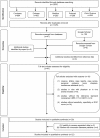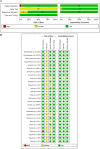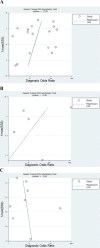Diagnostic ultrasound assessment of temporomandibular joints: a systematic review and meta-analysis
- PMID: 30285469
- PMCID: PMC6476374
- DOI: 10.1259/dmfr.20180144
Diagnostic ultrasound assessment of temporomandibular joints: a systematic review and meta-analysis
Abstract
Objectives:: The purpose of this systematic review was to determine the diagnostic capability of ultrasound to assess TMJ alterations as disc displacement (DD), joint effusion (JE) and condylar changes (CC) using 3D imaging modalities as reference standard.
Methods:: Studies were gathered by searching several electronic databases and partial grey literature up to January eighth, 2018 without restrictions of language and time. The risk of bias was evaluated using the second version of Quality Assessment Tool for Diagnostic of Accuracy Studies-2 (QUADAS-2). The grading of Recommendation, Assessment, Development and Evaluation (GRADEpro system) instrument was applied to assess the level of evidence across the studies.
Results:: After applying the eligibility criteria, 28 studies were identified and synthesized. All studies were methodologically acceptable presenting low applicability concerns, although none of them fulfilled all QUADAS-2 criteria. The quantitative analysis included 22 studies, 2829 joints in total. The quality of the evidence evaluated by GRADE system suggested moderate confidence in estimating the outcomes.
Conclusion:: This systematic review demonstrated the ultrasound has acceptable capability to screen for DD and JE in TMD patients. For screening of condylar changes, ultrasound needs further studies using CT or CBCT as reference standard to support its use. More advanced imaging such as MRI can thereafter be used to confirm the diagnosis if deemed necessary.
Keywords: systematic review; temporomandibular joint; temporomandibular joint disorder; ultrasound.
Conflict of interest statement
Figures





Similar articles
-
Ultrasonography in the Diagnosis of Temporomandibular Disorders: A Meta-Analysis.Med Sci Monit. 2018 Feb 8;24:812-817. doi: 10.12659/msm.908810. Med Sci Monit. 2018. PMID: 29420457 Free PMC article.
-
Ultrasonography of the temporomandibular joint: comparison of findings in patients with rheumatic diseases and temporomandibular disorders. A preliminary report.Oral Surg Oral Med Oral Pathol Oral Radiol Endod. 2005 Oct;100(4):481-5. doi: 10.1016/j.tripleo.2005.02.071. Oral Surg Oral Med Oral Pathol Oral Radiol Endod. 2005. PMID: 16200679
-
Use of ultrasonography for the diagnosis of temporomandibular joint disorders: a review.Am J Dent. 2007 Apr;20(2):73-8. Am J Dent. 2007. PMID: 17542198 Review.
-
Temporomandibular joint assessment in MRI images using artificial intelligence tools: where are we now? A systematic review.Dentomaxillofac Radiol. 2025 Jan 1;54(1):1-11. doi: 10.1093/dmfr/twae055. Dentomaxillofac Radiol. 2025. PMID: 39563454 Free PMC article.
-
Morphological changes in temporomandibular joint architecture in patients with temporomandibular disorders: systematic review protocol.BMJ Open. 2024 Sep 13;14(9):e082396. doi: 10.1136/bmjopen-2023-082396. BMJ Open. 2024. PMID: 39277206 Free PMC article.
Cited by
-
Examination of Joint Effusion Magnetic Resonance Imaging of Patients with Temporomandibular Disorders with Disc Displacement.J Imaging. 2024 Sep 27;10(10):241. doi: 10.3390/jimaging10100241. J Imaging. 2024. PMID: 39452404 Free PMC article.
-
The Role of Ultrasound in Temporomandibular Joint Disorders: An Update and Future Perspectives.Front Med (Lausanne). 2022 Jun 20;9:926573. doi: 10.3389/fmed.2022.926573. eCollection 2022. Front Med (Lausanne). 2022. PMID: 35795636 Free PMC article. Review.
-
Effectiveness of ultrasonography in the diagnosis of temporomandibular joint disorders: A systematic review and meta-analysis.J Oral Rehabil. 2025 Feb;52(2):243-253. doi: 10.1111/joor.13807. Epub 2024 Jul 18. J Oral Rehabil. 2025. PMID: 39023186 Free PMC article.
-
Hand-Carried Ultrasonography Instrumentation in the Diagnosis of Temporomandibular Joint Dysfunction.Methods Protoc. 2021 Nov 6;4(4):81. doi: 10.3390/mps4040081. Methods Protoc. 2021. PMID: 34842776 Free PMC article.
-
Ultrasonographic and Radiographic Evaluation of Osteoarthritic Changes in the Temporomandibular Joint.Diagnostics (Basel). 2025 May 2;15(9):1160. doi: 10.3390/diagnostics15091160. Diagnostics (Basel). 2025. PMID: 40361978 Free PMC article.
References
-
- Dworkin SF, LeResche L. Research diagnostic criteria for temporomandibular disorders: review, criteria, examinations and specifications, critique. J Craniomandib Disord 1992; 6: 301–55. - PubMed
-
- Schiffman E, Ohrbach R, Truelove E, Look J, Anderson G, Goulet JP, et al. . International RDC/TMD Consortium Network, International association for Dental Research; Orofacial Pain Special Interest Group, International Association for the Study of Pain. Diagnostic Criteria for Temporomandibular Disorders (DC/TMD) for Clinical and Research Applications: recommendations of the International RDC/TMD Consortium Network* and Orofacial Pain Special Interest Group. J Oral Facial Pain Headache 2014; 28: 6–27. - PMC - PubMed
-
- Alkhader M, Ohbayashi N, Tetsumura A, Nakamura S, Okochi K, Momin MA, et al. . Diagnostic performance of magnetic resonance imaging for detecting osseous abnormalities of the temporomandibular joint and its correlation with cone beam computed tomography. Dentomaxillofac Radiol 2010; 39: 270–6. doi: 10.1259/dmfr/25151578 - DOI - PMC - PubMed
Publication types
MeSH terms
LinkOut - more resources
Full Text Sources
Medical

